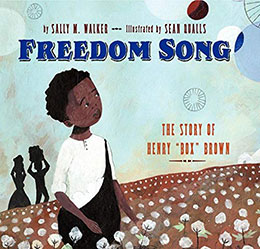
Freedom Song:
The Story of Henry “Box” Brown
About the Book
Henry “Box” Brown’s ingenious escape from slavery is celebrated for its daring and originality. Throughout his life, Henry was fortified by music, family, and a dream of freedom. When he seemed to lose everything, he forged these elements into the song that sustained him through the careful planning and execution of his perilous journey to the North.
Awards and Recognition
- Chicago Public Library Best Books 2012
- Indiana Young Hoosier Award Reading List
- Irma Black Award 2013 semifinalist
Reviews
“Brown is famous as a slave who had himself packed into a wooden box and shipped from Virginia to freedom in Pennsylvania…. After discovering that Brown sang in his church choir, Walker … built her story around the man’s love of music. She imagines him as a child, surrounded by a loving family “even though they were slaves on Master’s plantation,” making up songs to help him through the toil of the day: a “workday song” in the fields, a “gather-up song” in the garden, then the “freedom song” he only can sing quietly at night. As an adult, Brown marries and is devastated when his wife’s master sells her and their children. Inconsolable, he and a white man named Samuel Smith come up with the shipping plan. A letter from the man who receives the box describes how Brown came out of it and sang a hymn, a fitting finale to Walker’s rhythmic text. Qualls’s primitive-style collage illustrations strongly convey the depth of Brown’s emotions.” (School Library Journal, starred review)
“… Walker, inspired by the discovery that Henry Brown sang for many years in a church choir, takes a more poetic but equally successful tack, imagining that rhythm and song sustained Brown throughout his years of enslaved labor and inspired him to seek his freedom when his wife and children were sold away from Virginia. Walker infuses her text and Brown’s thoughts with patterned phrasing, from the “twist, snap, pick-a-pea” work songs he sang in the fields, to the “freedom-land, family, stay-together words” that comforted him as a child, to the “stay-still, don’t move, wait-to-be-sure words” that kept him silent as he waited for release from his shipping crate. Qualls’ mixed-media illustrations, far more dreamy and stylized than Nelson’s near-photorealistic renderings, are nonetheless an excellent match for Walker’s text. Even his signature aquas and pinks, embellished with free-floating bubbles, are tempered with more sober grays, browns, and deep blues, and weighted with heavily textured brushwork. An author’s note touches on Walker’s research and what little is known of Brown’s subsequent history; also appended is the fascinating text of a letter from Brown’s accomplice in 1849, detailing Brown’s escape and cautioning the recipient, “for Heaven’s sake don’t publish this affair or allow it to be published. It would … prevent all others from escaping in the same way.” (Bulletin of the Center for Children’s Books, starred review)

written by Sally M. Walker
illustrated by Sean Qualls
HarperCollins, Jan 2012
hardcover: 978–0060583101
40 pages, ages 5 and up

